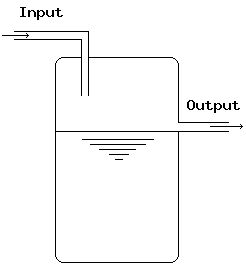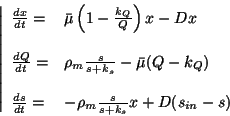The chemostat
Biological device
A chemostat is a laboratory device (of the bioreactor type)
in which organisms (bacteria, phytoplankton) grow in a controlled way.
A chemostat can be schematized the following way:
 Organisms whose growth is to be studied are placed in the
chemostat chamber. These organisms are "fed" by the input of nutrient to
the system, with a rate D and a concentration sin.
Organisms whose growth is to be studied are placed in the
chemostat chamber. These organisms are "fed" by the input of nutrient to
the system, with a rate D and a concentration sin.
There are three functioning modes for bioreactors:
-
"batch". The input and the output are zero. There is exponential
of organisms.
-
"fed batch". The output is zero. This is the preferred functioning
mode, when the goal is control of the population.
-
"continuous". The input rate equals the output rate, so the
volume in the chamber is constant.
For chemostats, it is the third mode (continuous) that is
preferred. Hence the contents of the chamber (both nutrient and phytoplankton)
exits the chemostat at the rate D.
Usual mathematical models of phytoplankton growth in the chemostat
Monod model
Let x be the phytoplankton biomass in the chemostat
chamber, and s the substrate concentration. Assuming that x
and s are expressed in the same units, the Monod model is then

where  is the Michaelis-Menten growth function (
is the Michaelis-Menten growth function ( is the maximal growth rate and ks is the half-saturation
constant).
is the maximal growth rate and ks is the half-saturation
constant).
Droop model
In this model another variable is introduced, the intracellular
substrate concentration, denoted Q.

References
H. L. Smith and P. Waltman. The theory of the chemostat. Dynamics of
microbial competition. Cambridge Studies in Mathematical Biology. Cambridge
University Press, 1995.
Back to the main page.



